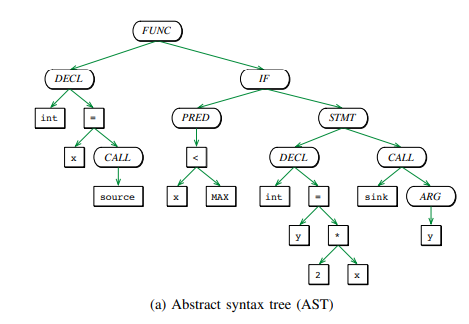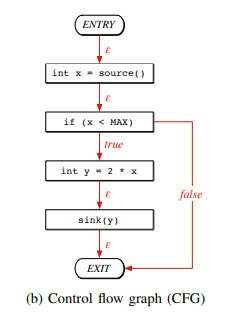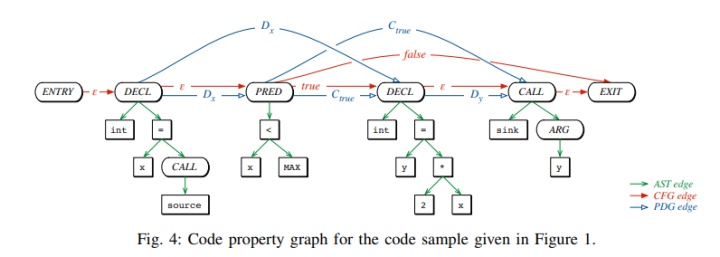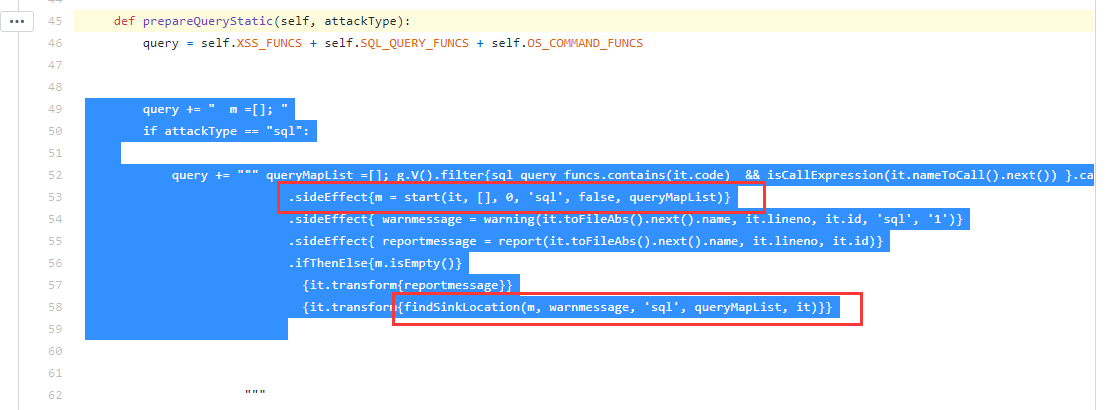
从了解到修复 Navex, 其中花了一年多, 从对自动化代码审计一无所知到学习PL/Static Analysis, 翻阅十几年前的文档, 补全Gremlin Step, 理解AST,CFG,DDG,PDG,CPG, 也感谢z3r0yu师傅和Gaba哥的的交流指导.
本文重点在于静态分析 Joern-图查询部分, 后面的动态分析自动生成EXP部分是剪枝的过程, 也相对好实现, 各位有兴趣的话, 我会在下一篇文章继续谈论.
这里不得不说的Navex实际的效果没有描述的那么优秀, 以及作者故意在代码里埋坑, 毕竟人家也研究了快十年, 留一手也是正常的.
这里不是说一定非要完成/使用Navex, 而是借鉴新鲜的学术思想, 结合实际环境实现相关功能来降低排查漏洞成本.
预备知识
Navex 是什么
下面这段摘自z3r0yu师傅的博文 Navex
NAVEX->Precise and Scalable Exploit Generation for Dynamic Web Applications
出处:27th USENIX Security Symposium
作者:Abeer Alhuzali, Rigel Gjomemo, Birhanu Eshete, and V.N.
单位:Venkatakrishnan University of Illinois at Chicago
资料:Paper | Github
作者在本文中提出了一种以静态分析作为指导,结合动态分析自动验证漏洞并构造可用exploit的工具NAVEX。
研究问题:
- 解决以往自动化审计的误报以及必须结合人工参与构造Exp的问题;
- 静态分析虽然覆盖率高,但是对于具有动态特性的语言其建模困难。解决方案:
- 静态分析阶段:使用符号执行创建Web应用程序的各个模块的行为模型。标记出包含潜在漏洞点的模块;
- 动态分析阶段:使用Web爬虫和concolic执行器去发现可能导致攻击者进入易受攻击模块的可能的HTTP导航路径,之后使用约束求解器生成一组对漏洞进行利用的HTTP输入序列。
方案优点:. - 动态分析与静态分析相结合提升了性能,可以应用于大型应用程序;
- 是一种多类型漏洞的Exp生成框架。
NAVEX分析了320万行PHP代码,自动构建并利用204个漏洞,其中有195个与SQLI和XSS相关,而9个与逻辑漏洞相关。此外NAVEX是第一个可以自动发现并利用EAR漏洞的方案。
Joern 静态分析核心模块
Joern 是ShiftLeft公司开发的用于C/C++代码健壮性分析的平台. 其核心思想: 将代码分析问题转化为用Gremlin去遍历存储在Neo4j中的CPG(代码属性图). 其商业产品 Ocular 支持多种语言, 也侧面证明 CPG 作为一种 IR, 是可以解决大部分语言的审计问题.
PS. 静态分析这部分其实可以使用Codeql代替.
CPG 代码属性图
CPG (代码属性图) 的论文可以参考
Modeling and Discovering Vulnerabilities with Code Property Graphs
这里用几张图简要描述一下
原始代码

代码对应的AST(抽象语法树)

代码对应的CFG(控制流程图)

代码对应的PDG(程序依赖图)

](https://blog.riskivy.com/wp-content/uploads/2020/05/4afab12ab74238d1b09a90517beabf9e.png)
代码对应的CPG(代码属性图)

其实以上的信息都可以从AST中获取, 只是后续的操作提高了单位节点的信息密集度, 对分析过程更友好
TinkerPop 2.x Gremlin 图查询语言
由于Navex作者是2012年开始研究这个方向, 所以大部分依赖都是远古版本, 我尽可能的修复了一些, 其中TinkerPop 2.x Gremlin由于官方已经更新 TinkerPop 3.x, 2.x 已经不再维护了, 全网只有一个github上面的历史文档
spmallette/GremlinDocs: Gremlin Documentation and Samples
或者阅读TinkerPop 2.x Gremlin的实现源码
tinkerpop/gremlin: A Graph Traversal Language (no longer active – see Apache TinkerPop).
其实更新为最新版的TP3(文档, 性能和语法都更好), 我也尝试过, 但是整个框架的Gremlin step需要重写, 不利于前期探索, TP2目前还够用, 所以如果后续有需要, 可以考虑整体重构.
目前的python-joern的实现方式是通过HTTP请求发送Gremlin查询语言(Groovy实现)到Neo4j的Gremlin插件
为什么不用Neo4j自带的Cypher, 因为Gremlin支持Groovy语法, 有更强的操作性, 也兼容其他图数据库
Tinkerpop 2.x Gremlin 基础知识
首先得了解Groovy的相关语法
精通 Groovy
TinkerPop 2.x Gremlin 文档查看这个
tinkerpop/gremlin: A Graph Traversal Language (no longer active – see Apache TinkerPop).
下面是我添加了一些注释, 方便理解
it
it 是groovy闭包中的默认参数
list.each {println it
}//等于list.each { obj ->println obj
}id
Gets the unique identifier of the element.
每个节点/边都有唯一的id
gremlin> v = g.V("name", "marko").next()
==>v[1]
gremlin> v.id
==>1
gremlin> g.v(1).id
==>1V
The vertex iterator for the graph. Utilize this to iterate through all the vertices in the graph. Use with care on large graphs unless used in combination with a key index lookup.
在 TP2中
g.V() 代表所有节点
g.v(1) 注意这里是小写的v, 可以用node_id取值
g.V("name", "marko") 返回 v.name=="marko" 的节点
gremlin> g.V
==>v[3]
==>v[2]
==>v[1]
==>v[6]
==>v[5]
==>v[4]
gremlin> g.V("name", "marko")
==>v[1]
gremlin> g.V("name", "marko").name
==>markoE
The edge iterator for the graph. Utilize this to iterate through all the edges in the graph. Use with care on large graphs.
返回节点的所有边
gremlin> g.E
==>e[10][4-created->5]
==>e[7][1-knows->2]
==>e[9][1-created->3]
==>e[8][1-knows->4]
==>e[11][4-created->3]
==>e[12][6-created->3]
gremlin> g.E.weight
==>1.0
==>0.5
==>0.4
==>1.0
==>0.4
==>0.2in
Gets the adjacent vertices to the vertex.
返回当前node的父节点
参数的调用可以不写 ()
- 没有参数的调用可以不写
() - 这个技巧在后面存储路径信息的时候会用到
g.v(4).inE.outV == g.v(4).in
g.v(4).outE.inV == g.v(4).out
gremlin> v = g.v(4)
==>v[4]
gremlin> v.inE.outV
==>v[1]
gremlin> v.in
==>v[1]
gremlin> v = g.v(3)
==>v[3]
gremlin> v.in("created")
==>v[1]
==>v[4]
==>v[6]
gremlin> v.in(2,'created')
==>v[1]
==>v[4]
gremlin> v.inE("created").outV
==>v[1]
==>v[4]
==>v[6]
gremlin> v.inE(2,'created').outV[0]
==>v[1]out
Gets the out adjacent vertices to the vertex.
返回当前node的子节点
gremlin> v = g.v(1)
==>v[1]
gremlin> v.outE.inV
==>v[2]
==>v[4]
==>v[3]
gremlin> v.out
==>v[2]
==>v[4]
==>v[3]
gremlin> v.outE('knows').inV
==>v[2]
==>v[4]
gremlin> v.out('knows')
==>v[2]
==>v[4]
gremlin> v.out(1,'knows')
==>v[2]both
Get both adjacent vertices of the vertex, the in and the out.
both 操作表示node 的相邻节点, 也就有有edge 存在, 且忽略 edge 的方向
gremlin> v = g.v(4)
==>v[4]
gremlin> v.both
==>v[1]
==>v[5]
==>v[3]
gremlin> v.both('knows')
==>v[1]
gremlin> v.both('knows', 'created')
==>v[1]
==>v[5]
==>v[3]
gremlin> v.both(1, 'knows', 'created')
==>v[1]Transform
Transform steps take an object and emit a transformation of it.
Transform 操作可以返回其后面闭包里面的值
Identity turns an arbitrary object into a “pipeline”.
gremlin> x = [1,2,3]
==>1
==>2
==>3
gremlin> x._().transform{it+1}
==>2
==>3
==>4
gremlin> x = g.E.has('weight', T.gt, 0.5f).toList()
==>e[10][4-created->5]
==>e[8][1-knows->4]
gremlin> x.inV
==>[StartPipe, InPipe]
==>[StartPipe, InPipe]
gremlin> x._().inV
==>v[5]
==>v[4]has
使用has可以做一些简单的属性判断
Allows an element if it has a particular property. Utilizes several options for comparisons through T:
- T.gt – greater than
- T.gte – greater than or equal to
- T.eq – equal to
- T.neq – not equal to
- T.lte – less than or equal to
- T.lt – less than
- http://T.in – contained in a list
- T.notin – not contained in a list
It is worth noting that the syntax of has is similar to g.V("name", "marko"), which has the difference of being a key index lookup and as such will perform faster. In contrast, this line, g.V.has("name", "marko"), will iterate over all vertices checking the name property of each vertex for a match and will be significantly slower than the key index approach. All that said, the behavior of has is dependent upon the underlying implementation and the above description is representative of most Blueprints implementations. For instance, Titan will actually try to use indices where it sees the opportunity to do so. It is therefore important to understand the functionality of the underlying database when writing traversals.
gremlin> g.V.has("name", "marko").name
==>marko
gremlin> g.v(1).outE.has("weight", T.gte, 0.5f).weight
==>0.5
==>1.0
gremlin> g.V.has('age').name
==>vadas
==>marko
==>peter
==>josh
gremlin> g.V.has('age',T.in,[29,32])
==>v[1]
==>v[4]
gremlin> g.V.has('age').has('age',T.notin, [27,35]).name
==>marko
==>josh[i]
A index filter that emits the particular indexed object.
通过下标可以进行取值, 跟Python的数组相似
gremlin> g.V[0].name
==>lop[i..j]
A range filter that emits the objects within a range.
下标也可以取范围. 前闭后开, [0,2)
gremlin> g.V[0..2].name
==>lop
==>vadas
==>marko
gremlin> g.V[0..<2].name
==>lop
==>vadasfilter
Decide whether to allow an object to pass. Return true from the closure to allow an object to pass.
filter操作就是通过一个闭包函数来过滤输入
//filter有时会失效,最好用has()
g.v(1).outE.has('label','created')
//g.v(1).outE.filter{it.label=='created'}groovy
infilter{}it.xxx()可能返回pipe对象
可以使用it.xxx().next()
来获取第一个节点
gremlin> g.V.filter{it.age > 29}.name
==>peterdedup
Emit only incoming objects that have not been seen before with an optional closure being the object to check on.
用于去除重复元素
gremlin> g.v(1).out.in
==>v[1]
==>v[1]
==>v[1]
==>v[4]
==>v[6]
gremlin> g.v(1).out.in.dedup()
==>v[1]
==>v[4]
==>v[6]as
Emits input, but names the previous step.
给一个操作设置一个别名, 配合select, loop
g.v(1).as('sloop').outE.inV.loop('sloop'){it.loops < 2}
循环体为 .outE.inV. 等价
g.v(1).outE.inV.loop(2){it.loops < 2}
gremlin> g.V.as('x').outE('knows').inV.has('age', T.gt, 30).back('x').age
==>29select
Select the named steps to emit after select with post-processing closures.
select 一般配合as一起使用
gremlin> g.v(1).as('x').out('knows').as('y').select
==>[x:v[1], y:v[2]]
==>[x:v[1], y:v[4]]
gremlin> g.v(1).as('x').out('knows').as('y').select(["y"])
==>[y:v[2]]
==>[y:v[4]]
gremlin> g.v(1).as('x').out('knows').as('y').select(["y"]){it.name}
==>[y:vadas]
==>[y:josh]
gremlin> g.v(1).as('x').out('knows').as('y').select{it.id}{it.name}
==>[x:1, y:vadas]
==>[x:1, y:josh]sideEffect
Emits input, but calls a side effect closure on each input.
官方示例中的是交互console, 可以延伸到下一条语句
gremlin> youngest = Integer.MAX_VALUE
==>2147483647
gremlin> g.V.has('age').sideEffect{youngest=youngest>it.age?it.age:youngest}
==>v[2]
==>v[1]
==>v[6]
==>v[4]
gremlin> youngest
==>27sideEffect可以在运行过程中执行指定操作, 但是不会影响遍历过程, 主要用于收集信息, 尽量不要用于改变节点信息
在python-joern中, sideEffect的作用域只在当前遍历过程/语句, 这里比较坑人, 大家注意
g.V.has('age').sideEffect{youngest=youngest>it.age?it.age:youngest}.transform{youngest}
ifThenElse
Allows for if-then-else conditional logic.
gremlin> g.v(1).out.ifThenElse{it.name=='josh'}{it.age}{it.name}
==>vadas
==>32
==>lop判断条件选择分支执行, 这边倾向于单独使用groovy的 if语句来处理, 逻辑更清晰
loop
Loop over a particular set of steps in the pipeline. The first argument is either the number of steps back in the pipeline to go or a named step. The second argument is a while closure evaluating the current object. The it component of the loop step closure has three properties that are accessible. These properties can be used to reason about when to break out of the loop.
it.object: the current object of the traverser.it.path: the current path of the traverser.it.loops: the number of times the traverser has looped through the loop section.
The final argument is known as the “emit” closure. This boolean-based closure will determine wether the current object in the loop structure is emitted or not. As such, it is possible to emit intermediate objects, not simply those at the end of the loop.
gremlin> g.v(1).out.out
==>v[5]
==>v[3]
gremlin> g.v(1).out.loop(1){it.loops<3}
==>v[5]
==>v[3]
gremlin> g.v(1).out.loop(1){it.loops<3}{it.object.name=='josh'}
==>v[4]loop应该这里最关键的操作, 可以参考
Loop Pattern · tinkerpop/gremlin Wiki
大部分的查询操作都需要loop进行配合
g.v(1).out.loop(1){it.loops<3}{it.object.name=='josh'}
大概等价于
arr = []
for (i=1; i<3; i++){if(it.object.name=='josh'){arr.add(it.object)}
}
return arr结合后面的enablePath, 可以在遍历的过程中获取当前所在的完整路径信息
g.v(1).out.loop(1){it.loops<3}{it.object.name=='josh' && it.path.contains(g.v(4))}.enablePath
大概等价于
arr = []
for (i=1; i<3; i++){if(it.object.name=='josh' && it.path.contains(g.v(4))){arr.add(it.object)}
}
return arrPipe.enablePath
If the path information is required internal to a closure, Gremlin doesn’t know that as it can not interpret what is in a closure. As such, be sure to use GremlinPipeline.enablePath() if path information will be required by the expression.
主要是保存路径信息
gremlin> g.v(1).out.loop(1){it.loops < 3}{it.path.contains(g.v(4))}
Cannot invoke method contains() on null object
Display stack trace? [yN]
gremlin> g.v(1).out.loop(1){it.loops < 3}{it.path.contains(g.v(4))}.enablePath()
==>v[5]
==>v[Pipe.next
Gets the next object in the pipe or the next n objects. This is an important notion to follow when considering the behavior of the Gremlin Console. The Gremlin Console iterates through the pipeline automatically and outputs the results. Outside of the Gremlin Console or if more than one statement is present on a single line of the Gremlin Console, iterating the pipe must be done manually. Read more about this topic in the Gremlin Wiki Troubleshooting Page.
There are some important things to note in the example below. Had the the first line of Gremlin been executed separately, as opposed to being placed on the same line separated by a semi-colon, the name of the vertex would have changed because the Gremlin Console would have automatically iterated the pipe and processed the side-effect.
gremlin> g.v(1).sideEffect{it.name="same"};g.v(1).name
==>marko
gremlin> g.v(1).sideEffect{it.name="same"}.next();g.v(1).name
==>same
gremlin> g.V.sideEffect{it.name="same-again"}.next(3);g.V.name
==>same-again
==>same-again
==>same-again
==>peter
==>ripple
==>joshnext 操作可以从pipe中取出对象 // pipe返回的一般都是生成器对象
path
Gets the path through the pipeline up to this point, where closures are post-processing for each object in the path. If the path step is provided closures then, in a round robin fashion, the closures are evaluated over each object of the path and that post-processed path is returned.
gremlin> g.v(1).out.path
==>[v[1], v[2]]
==>[v[1], v[4]]
==>[v[1], v[3]]
gremlin> g.v(1).out.path{it.id}
==>[1, 2]
==>[1, 4]
==>[1, 3]
gremlin> g.v(1).out.path{it.id}{it.name}
==>[1, vadas]
==>[1, josh]
==>[1, lop]
gremlin> g.v(1).outE.inV.name.path
==>[v[1], e[7][1-knows->2], v[2], vadas]
==>[v[1], e[8][1-knows->4], v[4], josh]path操作返回遍历的所有路径
simplePath
Emit the object only if the current path has no repeated elements.
gremlin> g.v(1).out.in
==>v[1]
==>v[1]
==>v[1]
==>v[4]
==>v[6]
gremlin> g.v(1).out.in.simplePath
==>v[4]
==>v[6]simplePath返回没有环路的path
toList
g.v(1).out //返回生成器
g.v(1).out.toList() //返回一个列表, 已经把数据都读出来了, 可以随便操作intersect
返回交集
[1,2,3].intersect([1])
=> [1][].intersect([1])
=> []Navex 排坑
被删除的查询语句
当你信心满满的解决了前面的各种古老依赖, 奇怪版本号问题时, 在最关键的查询语句是丢失的
如果你真的尝试运行了, 大概会这样
#python static-main.py the query is
xss_funcs = ["print", "echo"]
sql_query_funcs = ["mysql_query", "mysqli_query", "pg_query", "sqlite_query"]
os_command_funcs = ["backticks", "exec" , "expect_popen","passthru","pcntl_exec","popen","proc_open","shell_exec","system", "mail" ]m =[]; queryMapList =[]; g.V().filter{sql_query_funcs.contains(it.code) && isCallExpression(it.nameToCall().next()) }.callexpressions().sideEffect{m = start(it, [], 0, 'sql', false, queryMapList)}.sideEffect{ warnmessage = warning(it.toFileAbs().next().name, it.lineno, it.id, 'sql', '1')}.sideEffect{ reportmessage = report(it.toFileAbs().next().name, it.lineno, it.id)}.ifThenElse{m.isEmpty()}{it.transform{reportmessage}}{it.transform{findSinkLocation(m, warnmessage, 'sql', queryMapList, it)}}
Caught exception: <class 'py2neo.error.BadInputException'> groovy.lang.MissingMethodException: No signature of method: com.tinkerpop.gremlin.groovy.jsr223.GremlinGroovyScriptEngine.start() is applicable for argument types: (com.tinkerpop.blueprints.impls.neo4j2.Neo4j2Vertex, java.util.ArrayList, java.lang.Integer, java.lang.String, java.lang.Boolean, java.util.ArrayList) values: [v[721], [], 0, sql, false, []]
Possible solutions: wait(), any(), every()
None很显然是作者删除了关键函数
m = start(it, [], 0, 'sql', false, queryMapList) # 筛选sql注入节点
findSinkLocation(m, warnmessage, 'sql', queryMapList, it) # 查找Sink
所以你不可能直接复现论文里的静态分析结果, 世界上除了作者应该没人知道写的是啥了, issue中也有人反馈这样的问题
python-joern/Analysis.py at e5f651511143938511ae572b7986bfa92c6c4936 · aalhuz/python-joern

大部分想尝试的人, 面对这样未知的领域, 未知的语言, 未知的代码, 都会就此止步, 可惜了, 我不信邪, 哪怕重新写一个.
之后的时间, 去寻找“Tinkerpop Gremlin的教程, 然后学完百度的HugeGraph教程才发现市面上的文档都是针对Tinkerpop 3.x, 甚至又学习了一个宝藏博主的Tinkerpop 3.x`教程
PRACTICAL GREMLIN: An Apache TinkerPop Tutorial
想着触类旁通, 修复Tinkerpop 2.x的 Navex, 在一个完全陌生的领域探索必然是缓慢而痛苦的, 又过了很久, 找到 github上面的一份古老文档
spmallette/GremlinDocs: Gremlin Documentation and Samples
这是一份 2012-2015 年的Tinkerpop 2.x文档, 然后勉强把Tinkerpop 2.x文档扣了一遍, 中间穿插学习了编译原理, 离散数学, 南大的静态分析课程, 也算是知道了什么是静态分析, 大概的原理和目的也算是清楚了些.
在浏览器相关收藏快100个了的时候, 前后知识点终于打通了, 被迫完成了作者删除的代码, 回过头来看, 也不是特别难, 硬着头皮写Gremlin遍历, 边查边写就是了.
CPG – Vertex, Edge , Property
CPG的节点, 边和属性信息都记录在下面这个文件中
joern/phpjoernsteps/_constants.groovy
// AST node property keysObject.metaClass.NODE_INDEX = 'id' // 每个node都有自己的id
Object.metaClass.NODE_TYPE = 'type' // 节点的类型, 后面`AST node types`有具体描述
Object.metaClass.NODE_FLAGS = 'flags' // 参考`AST node flags`, 赋值, 二元操作,判断, 文件包含, 目录信息
Object.metaClass.NODE_LINENO = 'lineno' // 当前节点所处源文件的行数
Object.metaClass.NODE_CODE = 'code' // 引用的函数或者变量的名称
Object.metaClass.NODE_FUNCID = 'funcid' // 所处文件的文件id
Object.metaClass.NODE_ENDLINENO = 'endlineno' // 所处文件的总行数
Object.metaClass.NODE_NAME = 'name' // 函数声明的函数名称, 文件的文件名
Object.metaClass.NODE_DOCCOMMENT = 'doccomment' // 注释// AST node types
//g.V().has('type', TYPE_STMT_LIST)
Object.metaClass.TYPE_STMT_LIST = 'AST_STMT_LIST' // ...; ...; ...;
Object.metaClass.TYPE_CALL = 'AST_CALL' // foo()
Object.metaClass.TYPE_STATIC_CALL = 'AST_STATIC_CALL' // bla::foo()
Object.metaClass.TYPE_METHOD_CALL = 'AST_METHOD_CALL' // $bla->foo()
Object.metaClass.TYPE_PROP = 'AST_PROP' // e.g., $bla->foo
Object.metaClass.TYPE_FUNC_DECL = 'AST_FUNC_DECL' // function foo() {}
Object.metaClass.TYPE_METHOD = 'AST_METHOD' // class bla { ... function foo() {} ... }
Object.metaClass.TYPE_ARG_LIST = 'AST_ARG_LIST' // foo( $a1, $a2, $a3)
Object.metaClass.TYPE_PARAM_LIST = 'AST_PARAM_LIST' // function foo( $p1, $p2, $p3) {}
Object.metaClass.TYPE_PARAM = 'AST_PARAM' // $p1
Object.metaClass.TYPE_ASSIGN = 'AST_ASSIGN' // $buzz = true
Object.metaClass.TYPE_ASSIGN_REF = 'AST_ASSIGN_REF' // $b = &$a
Object.metaClass.TYPE_ASSIGN_OP = 'AST_ASSIGN_OP' // $x += 3
Object.metaClass.TYPE_NAME = 'AST_NAME' // names (e.g., name of a called function in call expressions)
Object.metaClass.TYPE_VAR = 'AST_VAR' // $v
Object.metaClass.TYPE_BINARY_OP = 'AST_BINARY_OP' // e.g., "foo"."bar" or 3+4
Object.metaClass.TYPE_ENCAPS_LIST = 'AST_ENCAPS_LIST' // e.g., "blah{$var1}buzz $var2 beep"
Object.metaClass.TYPE_INCLUDE_OR_EVAL = 'AST_INCLUDE_OR_EVAL' // eval, include, require
//Abeer
Object.metaClass.TYPE_CALLEE = 'Callee'
Object.metaClass.TYPE_FUNCTION = 'Function'
Object.metaClass.TYPE_ECHO = 'AST_ECHO' // echo
Object.metaClass.TYPE_PRINT = 'AST_PRINT' // PRINT//ABEER
Object.metaClass.TYPE_IF_ELEM = 'AST_IF_ELEM' // HOLDES THE COND INSIDE IF
Object.metaClass.TYPE_DIM = 'AST_DIM' // _POST[x]
Object.metaClass.TYPE_ISSET = 'AST_ISSET' // is_set()
// TODO and many more...// AST node flags
// of AST_ASSIGN.*
Object.metaClass.FLAG_ASSIGN_CONCAT = 'ASSIGN_CONCAT' // $v .= "foo"
// of AST_BINARY_OP
Object.metaClass.FLAG_BINARY_CONCAT = 'BINARY_CONCAT' // "foo"."bar"
//Abeer
Object.metaClass.FLAG_BINARY_EQUAL = 'BINARY_IS_EQUAL' // x==y
Object.metaClass.FLAG_BINARY_NOT_EQUAL = 'BINARY_IS_NOT_EQUAL' // x != y
Object.metaClass.FLAG_BINARY_IS_IDENTICAL = 'BINARY_IS_IDENTICAL' // 1 === 1
Object.metaClass.FLAG_BINARY_IS_NOT_IDENTICAL = 'BINARY_IS_NOT_IDENTICAL' // 1 !== 1
// of AST_INCLUDE_OR_EVAL
Object.metaClass.FLAG_EXEC_EVAL = 'EXEC_EVAL' // eval("...")
Object.metaClass.FLAG_EXEC_INCLUDE = 'EXEC_INCLUDE' // include "..."
Object.metaClass.FLAG_EXEC_INCLUDE_ONCE = 'EXEC_INCLUDE_ONCE' // include_once "..."
Object.metaClass.FLAG_EXEC_REQUIRE = 'EXEC_REQUIRE' // require "..."
Object.metaClass.FLAG_EXEC_REQUIRE_ONCE = 'EXEC_REQUIRE_ONCE' // require_once "..."// TODO and many more...// Other (non-AST) node types
// 目录结构信息
Object.metaClass.TYPE_DIRECTORY = 'Directory'
Object.metaClass.TYPE_FILE = 'File'Object.metaClass.TYPE_STRING = 'string'// Edge typesObject.metaClass.DIRECTORY_EDGE = 'DIRECTORY_OF'
Object.metaClass.FILE_EDGE = 'FILE_OF'
Object.metaClass.AST_EDGE = 'PARENT_OF'// 不清楚, dvwa里面没有这种边
Object.metaClass.TYPE_IDENTIFIER_DECL_STMT = 'IdentifierDeclStatement'
Object.metaClass.TYPE_PARAMETER = 'Parameter'Object.metaClass.TYPE_FILE = 'File'// Edge typesObject.metaClass.CALLS_EDGE = 'CALLS' // 类中的函数定义
Object.metaClass.CFG_EDGE = 'FLOWS_TO' // 用来描述 ControlFlowObject.metaClass.USES_EDGE = 'USE'
Object.metaClass.DEFINES_EDGE = 'DEF'
Object.metaClass.DATA_FLOW_EDGE = 'REACHES' // 用来描述 DataFlowObject.metaClass.FUNCTION_TO_AST_EDGE = 'IS_FUNCTION_OF_AST'
Object.metaClass.FILE_TO_FUNCTION_EDGE = 'IS_FILE_OF'// Edge keysObject.metaClass.DATA_FLOW_SYMBOL = 'var' // 如果这是一条`REACHES`的边, 就会有`var`这个key, 其值代表上一个节点流出到下一个节点的变量名//Abeer
// phpjoern 自带的过滤函数检测, 这里我们不用
Object.metaClass.DATA_FLOW_TAINT_SRC = 'taint_src'
Object.metaClass.DATA_FLOW_TAINT_DST = 'taint_dst'作者:斗象能力中心 TCC – 小胖虎
由于篇幅有限,有关漏洞查询代码补全分析、完整代码、安装与使用、查询结果分析、总结与参考内容将在 《复活Navex-使用图查询进行代码分析(下)》篇展示,记得持续关注哦~
如果想要获得「更多最前沿的安全技术研究与内容」欢迎关注‘斗象智能安全能力中心’
斗象能力中心 - 斗象智能安全blog.riskivy.comTCC Team长期招聘,包含各细分领域安全研究员[Web/网络攻防/逆向]、机器学习、数据分析等职位。感兴趣不妨发简历联系我们。
)





)








...)



